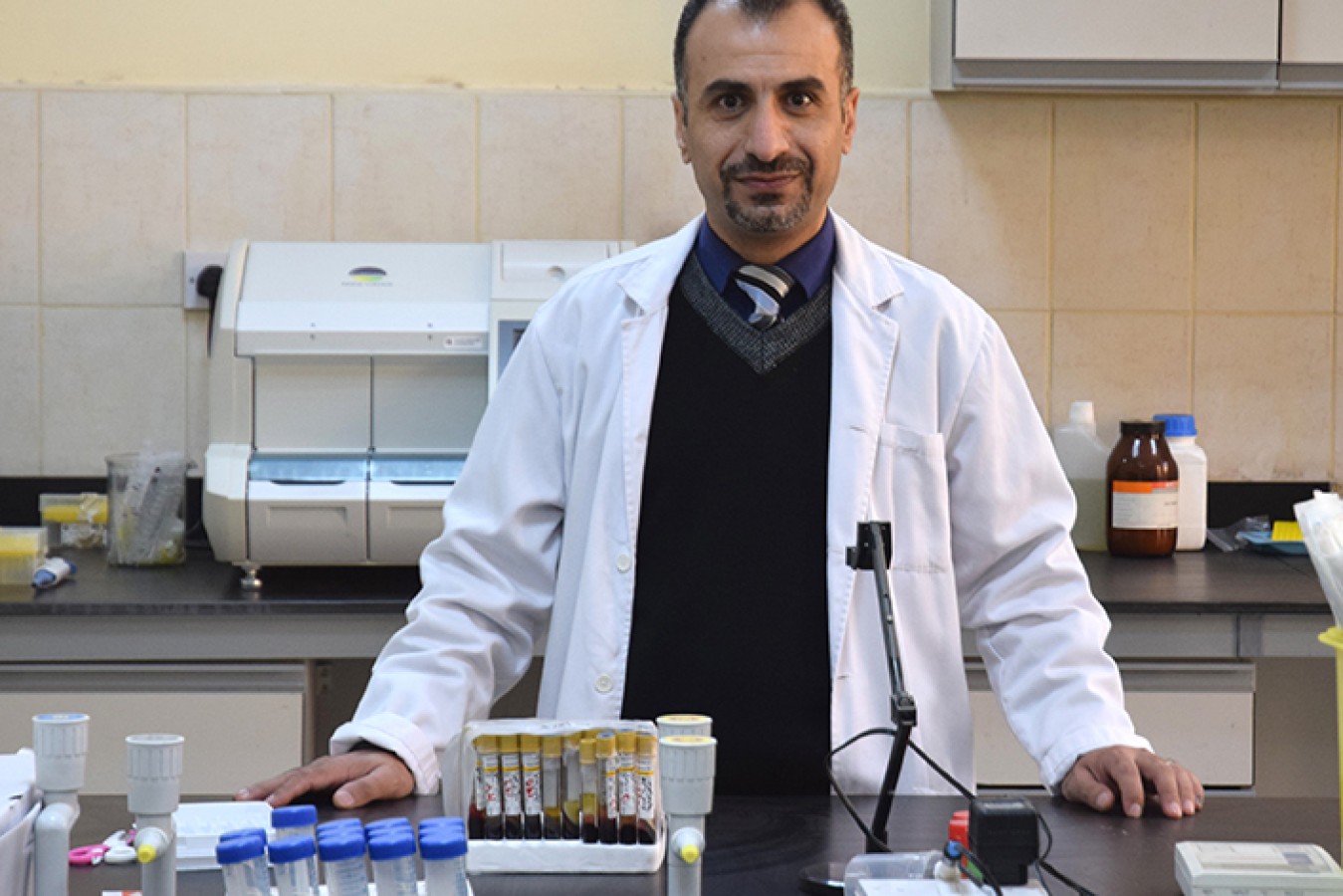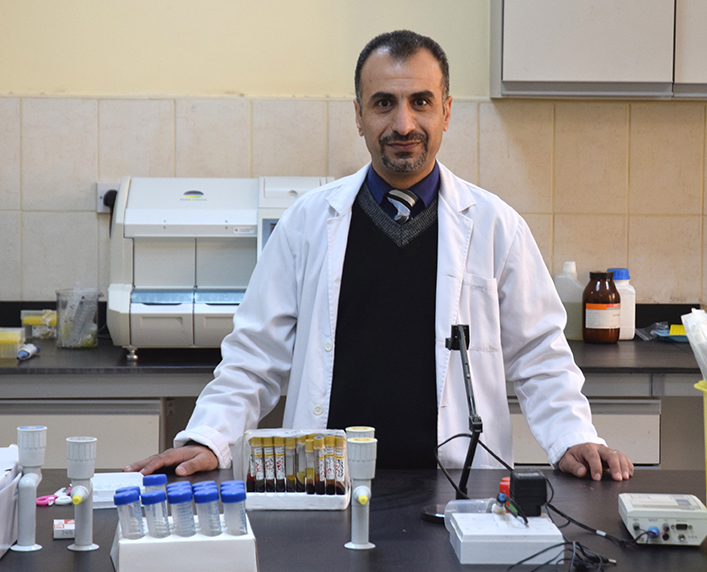

Funded Projects - Second Call
Development of a novel and cheap paper-based blood diagnostic test that reports results immediately in written text
Managed by
Dr. Mohammad Al-Tamimi fromThe Hashemite University

Current laboratory diagnostic testing is compromised by availability of well-equipped facilities, well-trained professionals, complexity, prolonged time, and high cost. Point-of-care (POC) assays are ideal solution to overcome limitations of typical laboratory tests. Many POC devices are currently used including pregnancy test, urine dipstick and glucose meters. Currently, there is an expulsion in research and development of POC devices worldwide.
Ideal POC devices are affordable, accurate, user friendly, rapid, and equipment-free. Paper-based POC devices that reports results in written text would be an ideal solution. It uses the accuracy of biological reagents within the paper matrix to provide unambiguous results. Such assays are not available for most medical diseases of importance to community including anemia, diabetes, hypothyroidism, hypercholesterolemia, and vitamin deficiency. Authors of this proposal have recently developed, validated, and patented the first text-reporting paper-based blood grouping POC.
The aim of this proposal is to establish the first paper-based POC assays for measurement (of at least three) hemoglobin, HbA1c, thyroid hormones, cholesterol, vitamin D and B12 levels. The study will include the following steps (1) Characterization of biological, chemical, and paper reagents. (2) Understanding the interaction between antibodies, antigens, and paper substrate. (3) Development of qualitative and quantitative reporting methods. (4) Optimization of tests accuracy and functionality. (5) Development of final test protype. (6) Application of test device through clinical studies. (7) Patenting and commercialization of successful tests.
The project will be performed in collaboration with a leading commercial company (MONOJO). Development of quantitative, equipment-free, rapid and cheap paper-based POC assays capable of providing results in numerical values is expected to be a huge -yet challenging- advancement in the field. The proposed project has scientific, academic, commercial and community outputs.
Utilization of Speed Breeding to Produce Climate-Smart Wheat Lines to Improve Productivity and Food Security in Dry Areas
Managed by:
Dr. Munqez Shtaya from An-Najah National University

Breeding climate-smart wheat varieties is needed to improve resilience against stresses and increase productivity. The pattern of crop development in stress-prone agricultural areas is an important trait determining its performance and yield. Major drivers of wheat development are seasonal changes in photoperiod and genetically encoded differences in photoperiod response.
Typically, stress-tolerant durum landrace genotypes require vernalization and are photoperiod sensitive and thus characterized by slow development under field conditions. By contrast, wheat elite lines carry alleles that confer photoperiod insensitivity and spring-type growth habit display accelerated development under long and short-day conditions. In the proposed study, durum and bread wheat material carrying photoperiod-insensitive and spring-growth habit alleles and drought-tolerant landraces and cultivars from different resources that were collected from the region were used to produce recombinant inbred lines population and advanced elite lines. The research team was successful in developing new advanced wheat breeding lines carrying photoperiod-insensitive and spring-growth habit alleles using Jordanian cultivars and landraces as parents.
Furthermore, bread wheat material carrying photoperiod-insensitive and spring-growth habit alleles and Jordanian landraces and cultivars with improved drought tolerance were collected. The main objective of the current study is to evaluate the agronomic performance and yield potential of the newly generated breeding lines under contrasting environments across Jordan.
The effect of allelic variation at photoperiod-related and vernalization-related genes in different genetic backgrounds will be assessed in bread and durum sets and correlated with the agronomic and yield performance of selected local checks. Best performing and stable wheat lines will be crossed with selected wheat cultivars and landraces and a speed breeding system coupled with marker-assisted selection will be deployed for future development of climate-smart wheat lines.
Development and Fabrication of Low-Cost, High-Tech Stretchable and Wearable Cardiac Sensor for Low-Resources Settings
Managed by:
Prof.Dr. Ala'aldeen Al-Halhouli From German Jordan University

The majority of the countries in German Jordanian and Africa are categorized as either low or middle-income countries with several low-resources settings poor healthcare systems. Several studies in the literature reported the urgent clinical needs in low-resources settings, mainly cardiovascular and respiratory diseases. Low-resources settings suffer from insufficient health care facilities and continuous check-ups due to the shortage in the medical staffs and the high number of patients.
Continuous monitoring of vital signs such as Beat-to-Beat pulsatility signal (BtBS) from which the HR, and abnormal rhythm can be detected with low-cost sensors. This can significantly decrease the mortality rates in refugee camps and low-resources settings and decrease the pressure on the healthcare system.
Moreover, the literature reported a significant increase in the mental health needs in the region in general where heart rate variability (HRV) is considered as one of the indicators for such issues. Therefore, the aim of this project is to develop a low-cost and accurate stretchable and wearable sensor that can detect the HR, HRV and abnormal beat rhythm. Two printing technologies will be used namely inkjet and screen printing for the fabrication of the sensor where the conductive ink will be deposited on stretchable and biocompatible substrates.
The sensor employs the change in the electrical conductance of the printed circuit caused by any vibration. The heart beats formulate small vibrations in the body where these vibrations can be detected using the developed sensor. Moreover, the sensor will be integrated with wireless communications connected to a server and health engine which will allow remote monitoring by clinicians.
 You are never too old to set another goal or to dream a new dream.
You are never too old to set another goal or to dream a new dream.



